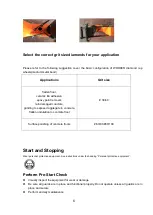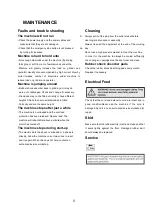
4
Diamonds Selection
Diamond
Diamond abrasives usually consist of 2 components,
⚫
Diamond power (also known as diamond crystals or grit)
⚫
A binding agent
The following are general rules regarding diamond segments in grinding applications
A.Diamond grit size
Changing the size of the diamond grit to a smaller particle/grit size will effect the performance of the
diamond tool in the following ways
⚫
Create a finer scratch pattern
⚫
Increase life of diamond tool
The opposite will occur when changing to a larger particle/grit size
B.Binding agent
Increasing hardness of bond will:
⚫
Create a finer scratch pattern
⚫
Increase life of diamond tool
⚫
Decrease production rate
The opposite will occur when making the metal or resin bond softer
Determining the hardness of concrete
Generally, the higher the compressive strength rating, the harder the concrete and therefore, the
harder it will be to grind
However, other factors beside compressive strength ratings determine how hard the floor will be, and
therefore, the correct diamond selection. Since grinding normally only deals with the surface of
concrete (top 5mm or 1/4 inch),often the way the concrete floor has been finished or the condition of
the surface will have a greater bearing on what type of diamond to select ,rather than the
compressive strength rating of the concrete
Surface factors to consider when making a diamond selection.
Generally, if concrete surface is very smooth (i.e.Most likely it has been heavily troweled/
helicoptered),the concrete will behave as if it has a high compressive strength and
therefore,require a soft bond segment.
Accordingly if concrete surface is coarse/aggressive (e.g.rain-damage,shot blast,scarified,exposed
aggregate e.t.c.) the concrete will behaves as if it has low compressive strength and
therefore,requires hard bond segment Surface coatings/contaminants (e.g. Epoxy coatings,ceramic
tile adhesives,leveling compounds/screeds) will often have a larger bearing on what diamond to
select,than will the compressive strength of the concrete.


























